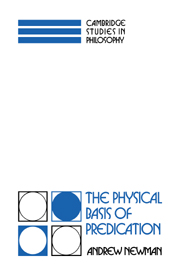Book contents
- Frontmatter
- Contents
- Acknowledgements
- Introduction
- Chapter 1 “Real constituents of the world”
- Chapter 2 What can logic and language tell us about reality?
- Chapter 3 The “existence” of universals and the notion of possibility
- Chapter 4 The causal significance of basic attributes
- Chapter 5 Hierarchies of universals
- Chapter 6 Causal relations
- Chapter 7 Arbitrary particulars and unified particulars
- Chapter 8 Further considerations concerning the causal relation
- Chapter 9 Arbitrary particulars and physical objects
- Bibliography
- Index
Chapter 5 - Hierarchies of universals
Published online by Cambridge University Press: 04 May 2010
- Frontmatter
- Contents
- Acknowledgements
- Introduction
- Chapter 1 “Real constituents of the world”
- Chapter 2 What can logic and language tell us about reality?
- Chapter 3 The “existence” of universals and the notion of possibility
- Chapter 4 The causal significance of basic attributes
- Chapter 5 Hierarchies of universals
- Chapter 6 Causal relations
- Chapter 7 Arbitrary particulars and unified particulars
- Chapter 8 Further considerations concerning the causal relation
- Chapter 9 Arbitrary particulars and physical objects
- Bibliography
- Index
Summary
DETERMINATES AND DETERMINABLES
Determinate attributes of particulars can be gathered into types; there are mass determinates, temperature determinates, length determinates, and so on. Not only do all mass determinates have something in common, but all particulars that have a mass determinate have something in common – they are all massive particulars. It follows that at least one type of universal other than determinate attributes is required.
There have been a number of accounts of what the extra common factor is, the two most obvious being what I call the second–order theory and the second–level theory. According to the second–order theory, all determinates of a certain type have a second–order attribute in common, a property of a property; what the particulars that have determinates of that type have in common has to be explained in terms of the second–order attribute. According to the second–level theory, all particulars that have determinates of a certain type have another attribute in common, a second–level attribute; what the determinates of a given type have in common is explained, in my version of this theory, by a relation of “subordination” between the determinate and a second–level attribute. The term ‘determinable’ is often reserved for what I have called the second–level attribute, which is a determinable in the classical sense, though the problem, irrespective of proposed solution, is usually called the problem of determinables. Although both determinate and determinable are first–order attributes, the relation between them of “subordination” is a second–order relation.
- Type
- Chapter
- Information
- The Physical Basis of Predication , pp. 100 - 135Publisher: Cambridge University PressPrint publication year: 1992



